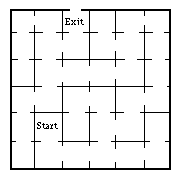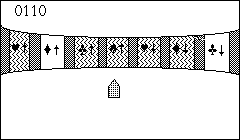HYPER-MAZE
Hyper-Maze is a four-dimensional maze game with a simple
80x25 screen interface.
It is available in
source
form without any warranty.
The game was inspired by the maze games
in the OICCC:
buzzard.c
by Sean Barrett (1991)
dodsond2.c
by Don Dodson (1995)
The maze consists of a four-dimensional cube sliced
in many little cubicles, the same way a square, i.e., a 2-D cube,
can be partitioned in many little squares arranged in a grid as in the
figure below.

Each cubicle is a room in the maze and
is described by its four coordinates in the slicing on the
big cube, just like two coordinates are sufficient to
describe the position of a little square in the grid of
the 2-D square.
Each room has (at most) eight nearby rooms, one to the left,
one to the right, one in front, one back, one above, one below,
one forward (in the fourth dimension), and one backward.
A room that touches a side of the big cube has fewer nearby rooms,
like the little squares on the side of the big square have less than
four nearby little squares.
Since this is a maze, it is not possible to move from a room
to all its nearby rooms; there are walls that prevent this,
and one can go from one room to a nearby room only if there is a door
in the wall between the two.

The player starts in a room deep inside the maze and must
get to the exit room (the only room with a door leading out of the maze).
From his/her point of view the player, standing in a room, sees
eight walls.
Some of the walls (at least one) have a door that leads
to a nearby room.
Each wall has a mark that indicates the direction:
the four directions are denoted by the four suits of the play-cards,
hearts, diamonds, clubs and spades, respectively.
There is also an arrow, indicating whether the coordinate increases
(uparrow) or decreases (downarrow) crossing the wall.
The room coordinates, specifying the absolute position of the
room in the maze-cube, appear on the top of the screen to help
the player.
The player can turn him/herself around by pressing the left and right
arrow keys.
Effectively he/she sees the walls flow on the screen in front of him/her.
When he/she is in front of a door he/she can enter the nearby room
by pressing the forward arrow key.
The game is over when the player reaches the exit room.

Marco Corvi - 1998

